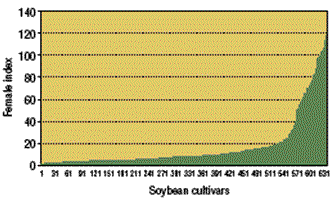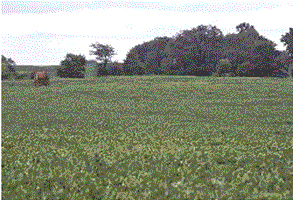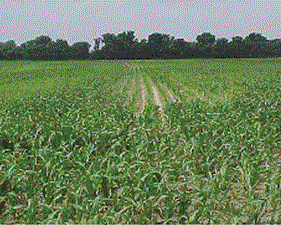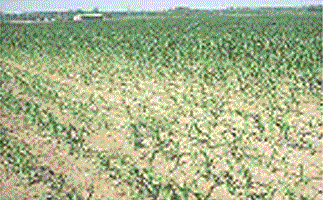So You Think You Can Ignore Nematodes? Think Again!
 |
Terry L. NiblackProfessor of NematologyPhone: (217) 244-5940 E-mail: tniblack@illinois.edu |
||
Nematodes are the pathogens that get no respect. Because they don't usually kill plants, and often don't cause any symptoms at all (except lower yields), many producers tend to ignore them. But even in a high-yield year like 2004, we saw nematode problems in soybean and corn that suggest you should move nematode testing up a few notches on your list of chores to do before next season.
Soybean Cyst Nematode: To Be (Resistant) or Not To Be
The soybean cyst nematode (SCN) continues to be the biggest soybean problem in Illinois. Every county in the state is now known to be infested with SCN, and the best estimate is that 80% of the soybean fields have the nematode. Losses due to SCN were minimal in 2004, and valued at around $100 million. But because root systems were generally so healthy in 2004, populations of SCN were allowed to build up to very high levels, which means bad news for the next soybean crop in those same fields (2006), if the weather is more typical for Illinois then.
In 2004, we screened 636 soybean cultivars that were labeled "resistant" to SCN for their actual levels of resistance. This screening program has grown from fewer than 100 cultivars 3 years ago. The screening program is a cooperative project funded by the Illinois Soybean Program Operating Board, involving the Soybean Variety Testing program headed by Emerson Nafziger, Southern Illinois University nematologist Jason Bond, USDA nematologist Greg Noel, and myself. We screen each soybean variety labeled by the seed company as "resistant" to five different SCN populations. Resistance is based on a "female index" (FI), which is the percentage of SCN on each test variety relative to the number of SCN on a standard susceptible, multiplied by 100. We define "resistant" as follows: FI values of 0 to 9 indicate a variety is highly resistant (HR); FI 10 to 24 = resistant (R); FI 25 to 39 = moderately resistant (MR); FI 40 to 59 = low resistance; FI 60+ = no effective resistance.
The example (Figure 1) shows the results for one SCN population, an HG Type 0 from Urbana. A couple of things are readily apparent from this graph. First, about half of the varieties are highly resistant to this SCN population. Second, there are still a number of varieties labeled as "resistant" that do not actually exhibit much resistance. Similar results were obtained for the other four SCN populations. All screening results are available on the web or in the VIPS booklet.
Soybean Cyst Nematode: Pay Attention to Your SCN Type!
SCN has been around in southern Illinois so long that many producers are ho-hum about it. It's probably time for soybean growers who know they have SCN to start questioning their complacency. Jason Bond, the nematologist at SIU-Carbondale mentioned above, collected soil samples from soybean fields throughout southern Illinois. 70% of the samples were positive for SCN, with an average population density of 9,438 eggs/100 cc soil. This level of infestation is high enough to cause significant yield loss even in resistant varieties (Figure 2).
We were curious about the ability of these SCN populations to infect resistant varieties, so the samples were tested in Urbana for their Illinois SCN Type. There are three types we worry about:
- SCN Type 1 is able to attack the soybean line Peking (also called PI548402) and any varieties whose resistance comes from Peking. These varieties are not common and represent only a small percentage of the resistant varieties used in southern Illinois.
- SCN Type 2 is able to attack the soybean line PI88788, which is the source of SCN resistance in over 90% of the resistant varieties grown in Illinois. This Type is of greatest concern to us because it limits the choices of resistant varieties available to growers.
- SCN Type 4 is able to attack the soybean line PI437654, which is the source of resistance in CystX® lines as well as the public varieties Hartwig and Ina.
We found that 82% of the SCN populations surveyed were Type 1.2 or 2. Type 1.2 can attack both Peking and PI88788, while Type 2 attacks only PI88788. These populations are also capable of reducing yields of resistant varieties carrying either type of resistance, depending on the number of eggs present.
In addition, 36% of the SCN populations surveyed were able to infect PI437654, the source of resistance in CystX® and other highly resistant soybean. These infections were at low levels, but they demonstrate that Illinois SCN populations possess the ability to attack this source of resistance and possibly build up over time.
Corn Nematodes: The Hidden Enemy
Nematodes are the most frequently overlooked cause of corn disease. The damage they cause is similar to that caused by any stress: stunting and chlorosis (Figure 3). Nematodes also can intensify expression of specific symptoms due to nutrient deficiency, herbicide injury, and other causes. The conventional wisdom about corn nematodes is that they damage corn only in sandy soils. This is completely untrue! Nematode injury to corn is not rare–it is simply difficult to identify.
The nematodes responsible for suppression of corn yields in Illinois are Hoplolaimus galeatus (lance nematode), Longidorus breviannulatus (needle nematode), Pratylenchus spp. (lesion nematodes), and Xiphinema americanum (dagger nematode). In 1994, the last year for which estimates are available, these nematodes were responsible for corn yield losses values at $81 million dollars in Illinois alone.
Lesion nematodes
Lesion nematodes sometimes called root-lesion nematodes or meadow nematodes, are probably the most economically important of the corn-pathogenic nematodes. There are at least 15 species that parasitize corn, of which three are well-documented pathogens of corn: P. brachyurus, P. hexincisus, and P. zeae. Eight species are known or potential pathogens of corn in Illinois. When lesion nematodes were controlled (usually through nematicides) in research plots, yield increases have been measured ranging from 10 to 54%. Lesion nematodes are found in virtually all crop production fields in Illinois, including most soil types, but usually are below damage thresholds.
Control of lesion nematodes, in the absence of suitable chemical controls, is dependent on species identification. Submit samples for species identification only to reputable, knowledgeable labs. Where polyspecific communities occur, crop rotation recommendations must be based on knowledge of host preference. Sanitation and natural-product based soil amendments have provided lesion nematode control in some cases.
Needle nematodes
Needle nematodes can cause spectacular losses—up to 62%–in infested fields (Figure 4). These nematodes damage corn roots by feeding on root tips, thereby stunting the lateral roots and essentially destroying the fibrous root system. Heavily parasitized seedlings may be killed. These nematodes are limited to soils with very high sand content.
In Illinois, very good threshold numbers for needle nematode damage have been established. One to five needle nematodes/100 cm3 soil can cause a moderate level of damage, whereas more than 25 can cause very severe damage. High rainfall amounts and cool temperatures in spring encourage the appearance of needle nematode damage. Infected corn plants can appear to grow out of early damage, but yield will nonetheless be significantly reduced.
Although relatively easy to diagnose, needle nematodes are not easy to control without nematicides. Management of needle nematodes requires monocotyledonous weed control, because the nematodes have a wide host range and can maintain and even increase their population densities on such weeds. Rotation to a nonhost crop, such as soybean, can reduce needle nematode populations if weed control is good.
Other nematodes
Lance nematode and dagger nematode are extremely common and may build up to population levels that can damage corn in Illinois. Sting nematode has been found in certain areas of southern Illinois, and is capable of damaging both corn and soybean.
The bottom line: don't ignore the possibility that you have a nematode problem just because you can't see damage occurring. Get in the habit of sampling on a regular basis for the presence of plant-parasitic nematodes in either corn or soybean.
Tables & Figures
 |
Figure 1. Resistance of 636
soybean varieties labeled as "resistant to soybean cyst nematode" relative to a standard susceptible variety. |
 |
Figure 2. Symptoms of SCN damage
on SCN–resistant soybean in southern Illinois. (Photo courtesy of J. Bond) |
 |
Figure 3. Damage due to stubby–root
nematode. |
 |
Figure 4. Corn damage due to
needle nematode. (Photo courtesy of D. Norton) |